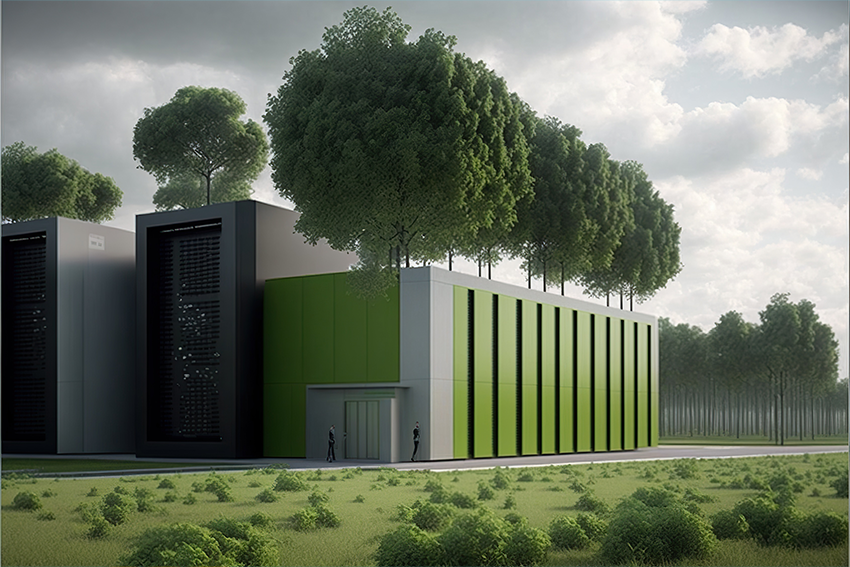As concerns over climate change and resource depletion continue to grow, the need for sustainable commercial buildings has become increasingly apparent. One industry that has made significant strides in this area is data centers, which have long been at the forefront of energy efficiency and environmental stewardship. By examining data center best practices, we can glean valuable insights into creating more sustainable commercial buildings. There are many topics we could delve into, such as renewable energy sourcing, or water management, but this article will focus on the value of integrating intelligent systems. Many of the features discussed below are commonly called Data Center Infrastructure Management (DCIM) in the data center world.
Integrate Intelligent Systems
Centralized Monitoring and Control
Big Brother has an upside.
Centralized monitoring and control systems provide a unified platform for managing and overseeing various aspects of data center operations, such as energy consumption, temperature, humidity, and equipment status. By integrating data from different sources and presenting it in a comprehensive and accessible manner, these systems enable data center operators to identify inefficiencies, track performance, and implement corrective measures in real-time. Centralized control also allows operators to automate various processes, such as adjusting cooling systems or managing power distribution, which can lead to significant energy savings and a reduction in the facility’s carbon footprint.
The advantages of centralized monitoring and control systems extend beyond data centers and can be applied to commercial buildings as well. In commercial buildings, a centralized system can collect data from various sub-systems, such as HVAC, lighting, and security, providing building managers with a holistic view of the facility’s performance – this is called Integrated Data Center Management (IDCM) in the data center world. This enables them to identify areas of inefficiency, optimize energy consumption, and reduce operating costs. Moreover, centralized monitoring and control systems can integrate with building automation systems, allowing for the automated adjustment of temperature, lighting, and ventilation based on factors such as occupancy, time of day, and external conditions. This results in a more comfortable and energy-efficient environment, ultimately contributing to a building’s sustainability goals. By implementing centralized monitoring and control systems, both data center operators and commercial building managers can make significant strides towards improving their facilities’ overall sustainability and reducing their environmental impact.
Real-Time Data Analysis
Late information is bad information.
Sustainable buildings benefit from analyzing real-time data to make adjustments and optimize operations. Real-time data analysis involves the continuous monitoring and assessment of various data streams, such as energy consumption, temperature, and equipment performance, to make informed decisions and implement immediate corrective actions. This enables data center operators to identify and rectify inefficiencies, optimize resource utilization, and prevent potential issues before they escalate, ultimately resulting in a more sustainable and energy-efficient operation. Real-time data analysis can also help data center operators to better manage and allocate resources during periods of high demand, as well as respond to dynamic conditions like fluctuating energy prices or grid stability concerns.
The benefits of real-time data analysis are not confined to data centers and can be applied to commercial buildings as well. In commercial buildings, real-time data analysis can be used to monitor various systems, such as HVAC, lighting, and security, providing facility managers with up-to-date information on building performance and energy consumption. This allows them to identify areas of inefficiency, implement targeted energy-saving measures, and reduce operating costs. Furthermore, real-time data analysis can facilitate demand response strategies by allowing commercial buildings to dynamically adjust energy consumption based on grid conditions, time-of-day pricing, or other factors. This can lead to substantial energy and cost savings while also contributing to the stability of the power grid and the integration of renewable energy sources. By leveraging real-time data analysis, both data center operators and commercial building managers can significantly improve their facilities’ sustainability and reduce their environmental footprint.
Planning and Forecasting
Fortune favors the prepared.
Data centers, being massive consumers of energy, rely heavily on advanced planning and forecasting to improve energy management and reduce operational costs. By leveraging historical data, real-time monitoring, and predictive analytics, data center managers can anticipate fluctuations in energy demand, infrastructure needs, and cooling requirements. This proactive approach allows them to optimize energy usage, schedule maintenance activities efficiently, and plan for future expansions or upgrades without compromising reliability or performance. Furthermore, data centers can implement demand-side management strategies, such as demand response programs, to minimize peak energy consumption and further enhance their energy management efforts.
Advanced planning and forecasting not only contribute to better energy management but also help data centers become more sustainable and environmentally friendly. By identifying trends and patterns in energy consumption, data center managers can develop targeted strategies to reduce their carbon footprint, such as adopting more energy-efficient hardware, optimizing cooling systems, and integrating renewable energy sources. Additionally, forecasting tools enable data centers to identify potential inefficiencies and implement corrective measures, ultimately leading to a more sustainable and efficient operation. Overall, advanced planning and forecasting play a critical role in driving data centers towards a greener and more energy-efficient future.
IoT Sensors and Smart Controls
Dumb sensors connected to a smart system is also smart sensing.
IoT sensors can monitor various aspects of data center operations, such as temperature, humidity, power consumption, and equipment performance, providing a wealth of real-time data that can be used to optimize efficiency and reduce waste. Smart controls, on the other hand, can autonomously manage and adjust different systems within the data center, such as cooling, power distribution, and lighting, based on the data collected by IoT sensors. This level of automation enables data center operators to respond to changing conditions more effectively, ultimately leading to a more sustainable and energy-efficient operation.
The advantages of IoT sensors and smart controls can also be applied to commercial buildings, helping to enhance their sustainability and reduce their environmental footprint. In commercial buildings, IoT sensors can be used to monitor various systems, such as HVAC, lighting, and security, providing facility managers with real-time data on building performance and energy consumption. Smart controls can then adjust these systems based on the data collected, optimizing energy use and creating a more comfortable environment for occupants. For instance, smart controls can automatically adjust temperature and lighting settings based on occupancy levels or time of day, resulting in significant energy savings and a reduced carbon footprint. Furthermore, IoT sensors can help detect potential issues in building systems, enabling facility managers to address them before they become costly problems. By integrating IoT sensors and smart controls into their operations, both data center operators and commercial building managers can significantly improve their facilities’ sustainability and contribute to a greener future.
These sensors need not be strictly “IoT” as narrowly defined. What is more important is to utilize intelligent sensing and share these sensed values with systems that can interpret the information and take actions based on the data. You’re making a smart system – the smarts don’t have to live on the sensor.
Machine Learning and AI-Driven Optimization
Machine learning is like a chameleon in a bag of Skittles: constantly adapting, but still struggling to find the right flavor.
Data center operators are increasingly harnessing the power of machine learning and AI-driven optimization to enhance their sustainable operations and reduce their environmental impact. Machine learning algorithms can process vast amounts of data, enabling data center operators to identify patterns, trends, and inefficiencies in energy consumption. By analyzing factors such as equipment performance, cooling systems, and environmental conditions, AI-driven optimization tools can provide actionable insights to improve energy efficiency, minimize waste, and reduce the overall carbon footprint. Furthermore, machine learning models can predict equipment failure and maintenance needs, allowing for proactive measures that not only extend the life of critical infrastructure but also optimize resource utilization.
The benefits of machine learning and AI-driven optimization are not limited to data centers and can be applied to commercial buildings as well. In commercial buildings, AI-based systems can analyze data from various sources, such as building automation systems, HVAC, lighting, and occupancy sensors, to optimize energy usage and reduce operating costs. By employing machine learning algorithms, these systems can dynamically adjust temperature and lighting settings based on occupancy patterns and external factors like weather conditions, resulting in a more comfortable and energy-efficient environment. Additionally, AI-driven predictive maintenance can help identify potential issues in building systems, such as HVAC, before they become costly problems, ultimately saving time, money, and resources. By adopting machine learning and AI-driven optimization, both data centers and commercial buildings can greatly improve their sustainability and reduce their impact on the environment.
Cutting edge building automation and control companies are beginning to employ similar techniques.
Demand Response and Energy Storage
The power couple in the energy world, always ready to step in and save the day when the grid throws a temper tantrum.
Demand response programs enable data center operators to adjust their electricity consumption during periods of high demand, usually by shifting non-critical processes to off-peak hours or utilizing stored energy. This not only helps in reducing the strain on the power grid, but also results in financial incentives for the participating data centers. By embracing demand response, data center operators can contribute to grid stability and support the integration of renewable energy sources like solar and wind, which often face intermittency challenges.
In addition to demand response, energy storage technologies play a vital role in fostering sustainable operations in data centers. Energy storage systems, such as batteries or flywheels, can store electricity during periods of low demand or excess generation from renewable sources, and release it when required. This not only provides backup power during outages, but also allows data centers to optimize their energy consumption patterns by utilizing stored energy during peak demand periods, thereby lowering energy costs and reducing reliance on fossil fuel-based power plants. Integrating energy storage solutions with renewable energy systems can further enhance the sustainability of data center operations, ensuring a reliable, cost-effective, and environmentally friendly power supply.
Conclusion
Integrating intelligent systems is a critical step in creating sustainable commercial buildings, a lesson learned from the innovative practices of data center operators. As discussed above, the use of advanced technologies such as machine learning, AI-driven optimization, centralized monitoring and control, real-time data analysis, and IoT sensors and smart controls can significantly enhance energy efficiency, optimize resource utilization, and reduce the overall environmental impact of operations.
The successful adoption of these intelligent systems in data centers serves as a model for commercial buildings, which can also greatly benefit from these technologies. By implementing similar strategies, commercial building managers can create more sustainable, comfortable, and cost-effective environments for occupants, while also contributing to global efforts to mitigate climate change and promote a greener future. As we continue to face the challenges of climate change and the growing demand for energy, it is essential for both data centers and commercial buildings to embrace the power of intelligent systems and pursue innovative solutions that support sustainable development and responsible resource management.
Additional Resources
Streamlining Data Center Management: The Benefits of Integrated Data Center Management (IDCM) – AutomatedBuildings.com
Driving Energy Efficiency and Sustainability Through Integration – AutomatedBuildings.com
Introduction to Integrated Data Center Management (IDCM) – YouTube




3 Responses